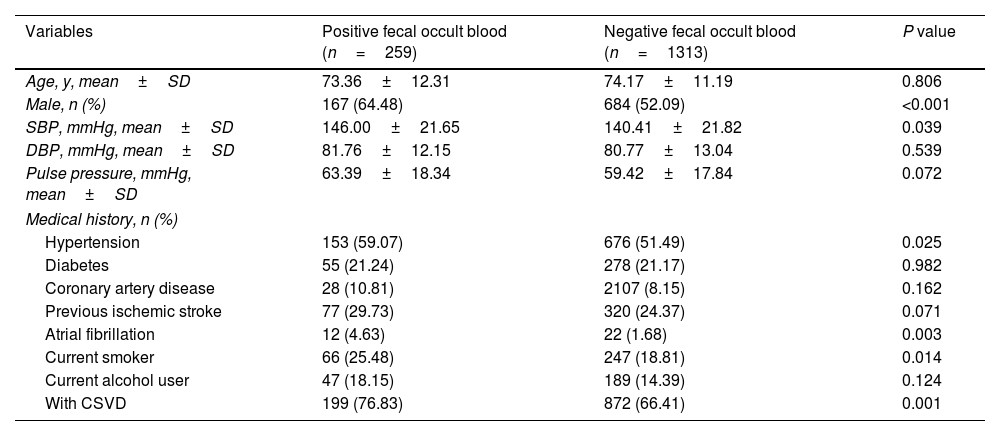Studies have shown that fecal occult blood is associated with an increased risk of ischemic stroke, but the relationship between fecal occult blood and cerebral small vessel disease (CSVD) remains largely unknown. This study aimed to identify predictors for CSVD, with fecal occult blood and its proxies as potential influencing factors in elderly patients.
MethodPatients aged 65 years or older with various chronic diseases were enrolled. The presence of CSVD was evaluated by brain MRI results. Fecal occult blood was measured by fecal immunochemical test. Logistic regression analysis was used for the association between the presence of fecal occult blood and the risk of CSVD.
ResultsLogistic regression analysis indicated that a prevalence of positive fecal occult blood was related to CSVD (Model 1, adjusted OR=1.63, 95% CI: 1.15–2.29, P=0.006). We subsequently grouped all subjects as positive fecal occult blood (259, 16.48%) and negative fecal occult blood (1313, 83.52%), and logistic regression analysis indicated that a prevalence of CSVD was related to positive fecal occult blood (Model 2, adjusted OR=1.50, 95% CI: 1.08–2.08, P=0.015). In addition, the ratios of lacunes (67.18% vs. 53.85%, P<0.001) and enlarged perivascular spaces (43.63% vs. 34.42%, P=0.005) were higher in patients with positive fecal occult blood than in controls.
ConclusionsThe presence of fecal occult blood is probably related to the risk of CSVD in elderly patients and could be used as a screening tool for CSVD in elderly populations.
Algunos estudios han demostrado que la sangre oculta en las heces está asociada con un mayor riesgo de accidente cerebrovascular isquémico, pero la relación con la enfermedad cerebrovascular de vaso pequeño (ECVP) está en discusión. El objetivo del presente estudio fue determinar dicha relación en pacientes mayores.
MétodosEl estudio incluyó pacientes mayores de 65 años con diversas enfermedades crónicas. La presencia de ECVP se evaluó a través de una RM cerebral. La sangre oculta en las heces se determinó mediante inmunoquímica fecal. Se llevó a cabo un análisis de regresión logística.
ResultadosSe observó una correlación entre la presencia de sangre oculta en heces y la ECVP (modelo 1, OR corregido=1,63, IC del 95%: 1,15-2,29, p=0,006). Posteriormente, se agruparon los sujetos positivos para sangre oculta (259 personas, 16,48%) y los negativos (1313 personas, 83,52%) y el análisis de regresión logística mostró que la prevalencia de ECVP se correlacionó con la presencia de sangre oculta en heces (modelo 2, OR ajustado=1,50, IC del 95%: 1,08-2,08, p=0,015). Además, en la RM los pacientes positivos tenían, respecto a los negativos, tasas más altas de imágenes lacunares (67,18% frente a 53,85%, p <0,001) y de espacio perivascular (43,63% frente a 34,42%, p=0,005).
ConclusiónLa presencia de sangre oculta en heces puede estar relacionada con el riesgo de ECVP en pacientes de edad avanzada y puede ser una herramienta de detección para la misma.
Artículo
Comprando el artículo el PDF del mismo podrá ser descargado
Precio 19,34 €
Comprar ahora












